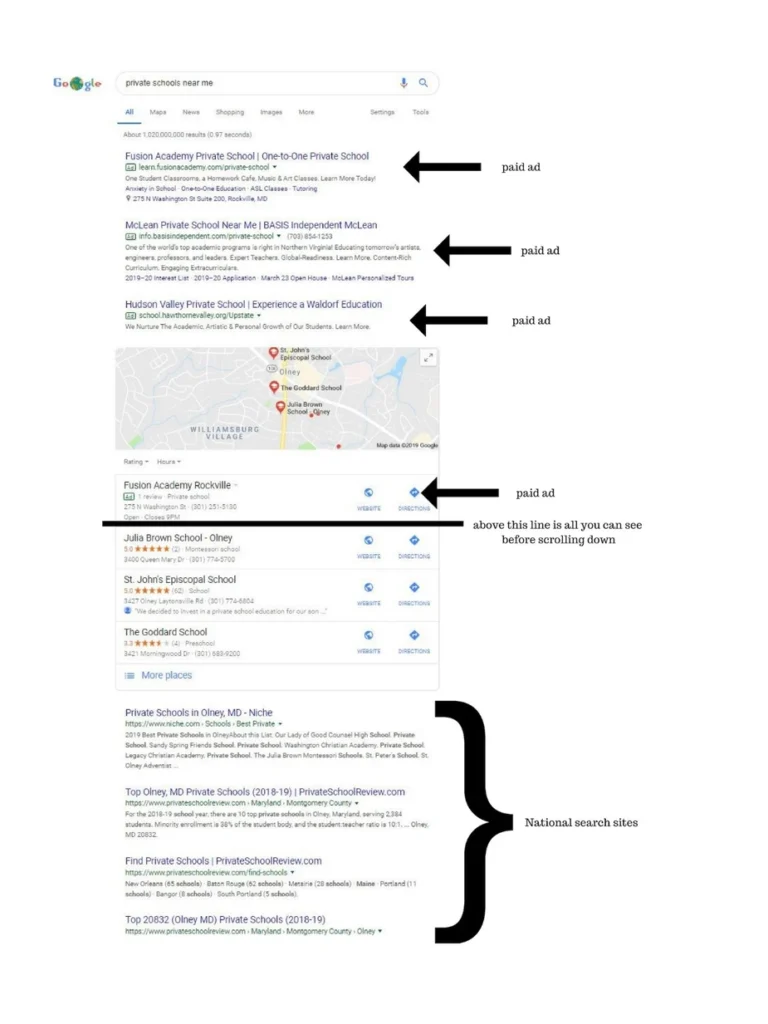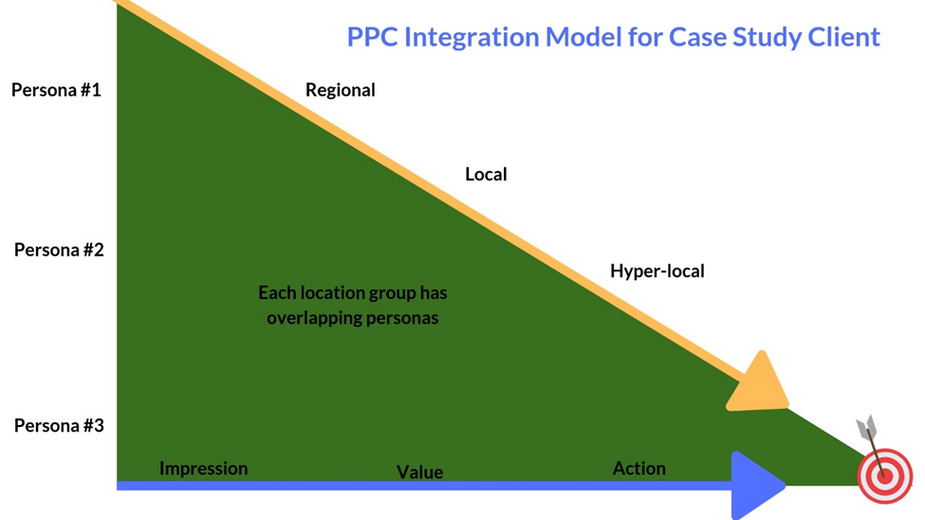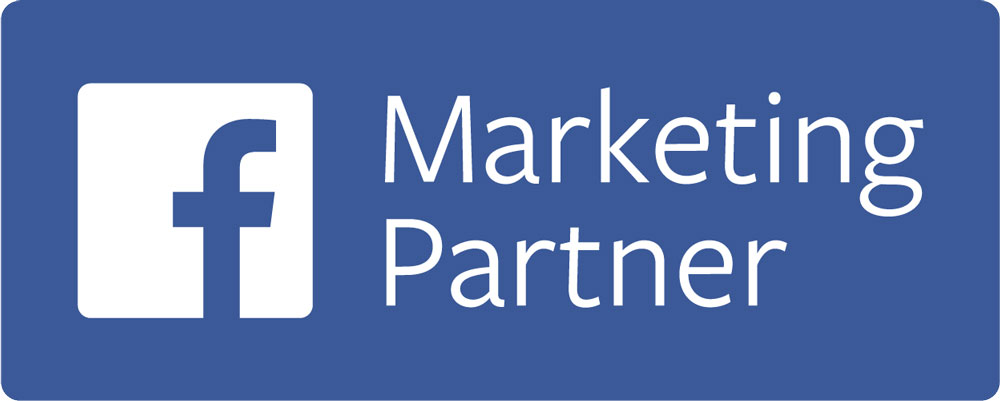By Trevor Waddington, Principal, Truth Tree
A strong digital presence is now the backbone of a solid independent school marketing strategy. It’s about getting consistent attention throughout the decision cycle by providing the right message at the right time to the right people. BTW – the “decision cycle” can also be called funnel and begins from the moment a first family contemplates independent education to the time they sign the enrollment contract.
So how do you get consistent attention in a highly competitive market where other schools and companies are trying just as hard to sell their goods or services?
Some in our space would say social media gets you the most attention. I agree. However, I don’t know anyone who says, ‘Honey, I think we should consider private school for little Jamie. I’ll go on Facebook and hope to find an ad.’
Others might tell you search engine optimization (SEO) is the key to victory, but take a quick look at the results below. I live in zip code 20832, and I searched for “private schools near me.” The first organic result about a single school doesn’t show up until the 12th result – it’s not even on page 2 – and most schools barely show up organically on page 3!

In this blog post, I’m going to take you through the planning, thinking, analyzing, and process-adjustment strategies for a successful private school pay-per-click digital marketing campaign that made our client very happy.
The Beginning
To get started, we first met with the client to determine their goals. They were interested in:
- expanding their private school branding, especially in certain micro-locations,
- improving enrollment in certain grades, and
- differentiating themselves from competitors.
The Research
Once we understood their goals, it was time to learn about the geo-behavioral psychographics of past, current, and projected customers. This step included intense internal and external market research. As a basic example, if your school is a buttoned-up, uniform wearing, traditional school, it is unlikely we will be pushing your ads to liberal-leaning progressives who have donated to Bernie Sanders.
Understanding the admission cycle of an independent school is also an essential pre-launch step.
At Truth Tree, we match the customer decision cycle and the independent school admission cycle with a three-part, storytelling strategy.
- Make an impression – Far too often schools assume they are known in their region and are shocked when faced with the reality that they are not. Most major cities in which our clients are located are highly transient, so impression-based marketing is critical. The messaging for this is basically, ‘Here we are. Here’s what we do. Contact us if interested’.
- Demonstrate value – At this point, they’ve heard of you. However, guess what, now they have heard of ten other schools too. You need to be pushing the benefits of your highly unique 5%, not the features of what 95% of other schools can claim.
- Get them to act – They know you. They understand you. They may even trust you. It’s time for action! Whether it’s attending an open house or signing up for a personalized tour, you must convert passive inquiries to passionate applicants.
Tip: For those not familiar with the independent school admission cycle, you still need to provide awareness and build trust to get someone to take action. Email drip campaigns are the perfect solution. Once you’ve captured their information with a content marketing piece on ‘5 Best Child-Friendly Restaurants in [the name of your town/city]’ You can start to push them periodic, trust-building emails. If you want to take it a step further, try to capture the names and ages of their children (not in the first capture), so you can automate emails to match your intake strategy.

The Formulation
After our research and analysis, we decided on a multi-layered plan that included three specific search campaigns. Each campaign would initially follow our impression –> value –> action formula since we were starting early enough in the decision cycle.
Campaign 1 – Broad Leads. This campaign was set up to accomplish their goal of an expanded brand footprint. We did not want to miss any potential leads, so our targeted was broad.
- The 11 ad groups provided impression-based, but bold headlines and descriptions.
- The 11 ad groups targeted different age/grade levels and very general personas.
- We used 144 phrase match keywords with some experimental longtail keywords.
- Our goal was to generate impressions, so a low click through rate (CTR) was expected.
Campaign 2 – Hyperlocal Leads. This campaign was dedicated to attracting families not far from the school who either live and/or work within 15 minutes of the school.
- 5 ad groups targeting the benefits of the “neighborhood” school along with benefit-based descriptions to differentiate from the hyperlocal competition.
- The 5 ad groups targeted specific personas.
- We used 45 phrase match keywords.
- Our goal was to dominate the hyperlocal audience searching for what this school offers age/grade-wise.
Campaign 3 – Testing. This campaign combined aspects of campaigns one and two. The primary function of this campaign was to push the envelope with messaging to a tiny audience and monitor it closely.
- This campaign would serve as our A/B testing campaign to see what was getting the most conversions based on our goals.
- We used 32 keywords ranging from broad to exact match.
- Our objectives were to determine which combinations would produce the best results.
Tip: If you want to shrink the radius area, use kilometers since they are a smaller unit of measure than miles.
Keywording
In all, we were using 167 total keywords and phrases throughout the campaign. While specific keywords can be obvious, other strategies are in our secret sauce. What I can tell you is be specific regarding ages/grades and programs offered beyond general ed. These longtail strategies might not yield you but a handful of impressions, but they are usually inexpensive clicks that convert to solid leads.
Persona Grata
As we designed the campaigns and mapped out the specific messaging, the devil is in the details as it pertains to the audience. Understanding the school’s parent personas was an essential step in determining the story language.
A keen grasp of what gets attention and motivates people is key to this step.
- Is the intent to inform, describe, convince or tell a story?
- Is the audience getting their first taste of the independent school world or are they third generation private school grads looking for their child?
- Who is going to cringe at “It’s the School 4 U” and who will applaud it?
- How emotional should the copy be and how mild or bombastic should it read?
- Which parent is going to be making the decision based on emotion and for which is it strictly business?
- Once approved by the school, we were ready to launch.
The Launch
The total budget was significant, but we always start with a few dollars a day. For the first week, each campaign had a $10 daily spend. This would be enough for us to make sure they were working, but not too much that if we made a miscalculation, it would cost the school a critical amount of their total budget.
Each day during the first week was dedicated to analyzing all aspects of the campaigns. We added new keywords, banished certain words/phrases to the negative keyword list (e.g., those looking for private school jobs or admission to a nursing home), and adjusted bidding.
After a few weeks to our surprise, the broad leads campaign was performing significantly better than anticipated at 3.90% CTR while the Hyperlocal was at 1.32%. We understood how expensive specific keywords would be in a certain area, but this was unexpected. What it showed us was that schools were starting to use Google Ads as a part of their marketing strategy and put a lot of their budget behind it. Because of that, we began to create longtail keywords and combinations of keywords. The results were tremendous. While we were still getting the expected impression volume, the CTR went up, and the cost per click went down.
Where Does the Click Go?
It was at this point that we came online with a dedicated landing page. We used previous analytic data to help curate the information on the landing page. We instructed our partner school to focus the page on three things:
- Elicit an emotional response.
- Provide a clear and convincing call to action statement to make contact.
- Ensure the initial contact form is very short. Your name and email address at a minimum. Additionally, the child’s name, grade inquiring for, phone, and address at maximum. Save the more extended form for when they are applying, but if you can input this above info to save them time. Even better.
Impression –> Value
As the cycle turned to the consideration stage from the parent side, we moved many of our ads from impression-based to value-based. In some cases, it was a small tweak to the language. In other cases, it was pointing the user to a different landing page.
At this time, we were also examining the competition and what they were pushing and paying for. Because many were not actively monitoring their bid strategies, we were easily able to outbid them when the time was most critical with powerful messaging to develop brand trust further.
Value –> Action
This can be the hardest for schools because most of us remember when we were solely in the driver’s seat. Demand was high, and the supply of seats was low. Today’s consumer needs you to tell them exactly what you want them to do.

At this stage, we continued to run our impression-based and value ads for those just entering the funnel, but for those deep within, it was time for them to do what you want. With admission events coming up, we took our best-performing ads and tweaked to include strong call-to-action statements like ‘click here to get invited to an open house,’ ‘schedule your private tour today,’ or ‘application deadline is approaching, apply now.’ Our strategy is to provide a sense of exclusivity or scarcity in addition to the direct call.
The Results
For this particular client, we did a six-month partnership. As you may recall, their goals were as follows:
- expanding its brand footprint,
- improving enrollment in certain grades, and
- differentiating themselves from competitors.
Our results as compared to the previous year:
- 46.80% new site visitors
- 15% increase in non-local applicants (those not located in predetermined zip codes)
- 29.92% increase in applications
- 18% more students accepted (demonstrating our understanding of their customer personas)
- 24% increase in newly enrolled students
- A waitlist in our most targeted grades
- A current enrollment higher than projected with more spots to fill
We were so excited for our clients. Not only were we able to help improve their enrollment and, ultimately, their revenue stream, but we were also able to teach them techniques along the way.
Truth Tree is more than a do-it-for-you firm. We pride ourselves on being teachers. That is why we spent time each week teaching the team on the other end our techniques, tactics, and strategies so they could eventually be their school’s brand superheroes.




